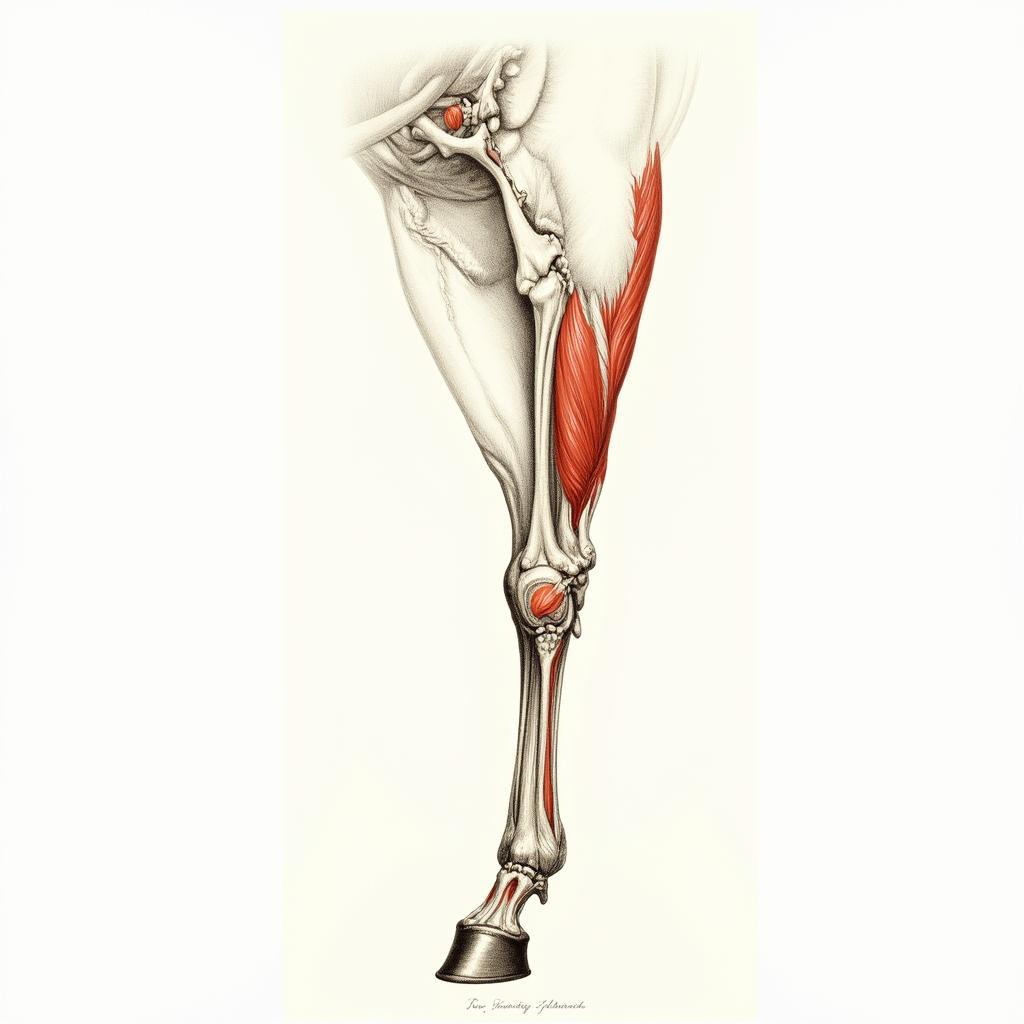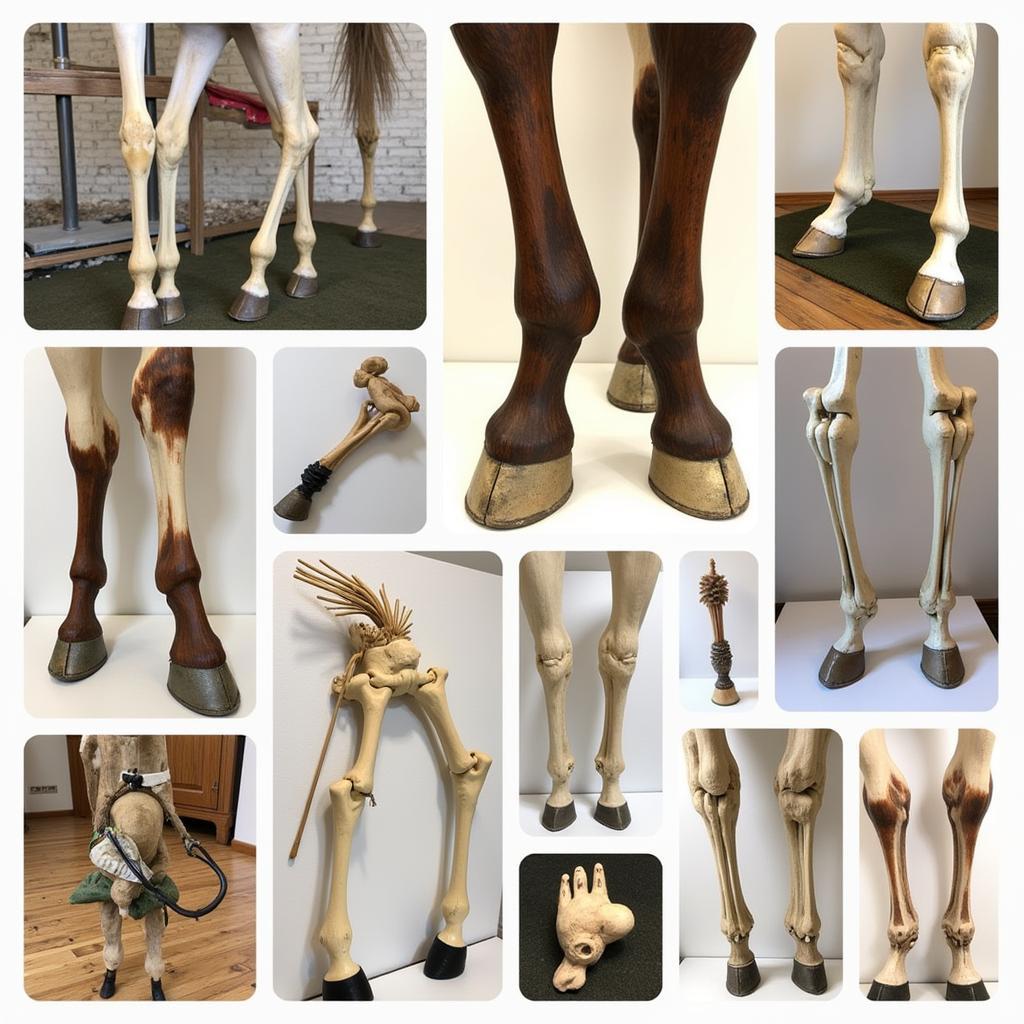The equestrian world is filled with traditions and unique ways of celebrating the majesty of horses. One such tradition is the “Horse Leg Display,” a practice that sparks curiosity and wonder. Whether you’re a seasoned horse enthusiast or new to the world of equines, understanding the reasoning and methods behind displaying horse legs can offer a fascinating glimpse into this unique aspect of horse culture.
 Horse Leg Anatomy Explained
Horse Leg Anatomy Explained
Why Display Horse Legs?
While the concept of displaying horse legs might seem unusual at first, it’s rooted in a deep appreciation for these magnificent animals. Here are some of the most common reasons why people choose to create and display horse leg presentations:
- Honoring a Legacy: Horse leg displays are often created to memorialize a beloved horse. This serves as a lasting tribute to their strength, beauty, and the special bond shared with their owner.
- Showcasing Conformation: Exhibiting the conformation, or skeletal structure, of a horse’s legs can be particularly important for breeders and those involved in competitive disciplines like racing or dressage. A well-conformed leg is essential for a horse’s movement and athletic ability.
- Anatomical Study: Veterinary students and artists often use horse leg displays as educational tools to study the complex anatomy of the equine leg.
- Decorative Art: Some individuals appreciate the unique aesthetic appeal of horse leg displays and incorporate them into their home decor as a conversation starter or a testament to their love for horses.
Crafting a Respectful Tribute: Ethical Considerations
It goes without saying that the creation of horse leg displays should always be approached with the utmost respect and ethical considerations. Sourcing legs ethically is paramount. Here are key factors to consider:
- Origin of the Legs: Ensure the legs are sourced ethically, either from a veterinarian who obtained them humanely or from a trusted source that specializes in preparing animal remains for display purposes. Never purchase legs from unknown sources or those suspected of illegal animal practices.
- Preparation and Preservation: The process of cleaning, preserving, and displaying horse legs requires specialized knowledge and techniques. It’s crucial to work with experienced professionals who understand how to handle and preserve the legs appropriately, preventing decay and ensuring a dignified presentation.
Types of Horse Leg Displays
Horse leg displays can range from simple and elegant to elaborate and artistic. Here are some of the most common types:
- Full Leg Display: This classic presentation involves preserving and mounting the entire leg, from hoof to upper leg bone. It offers a complete view of the horse’s leg structure and musculature.
- Cannon Bone Display: Focusing on the cannon bone, this type of display highlights the length and structure of this essential bone in the horse’s leg. It’s often chosen for its simplicity and elegance.
- Skeletal Horse Leg Display: In this type of display, the bones of the horse’s leg are cleaned, articulated, and mounted to showcase the skeletal structure. It’s a popular choice for educational purposes and veterinary studies.
 Variations of Horse Leg Displays
Variations of Horse Leg Displays
The Artistry of Preservation
Creating a horse leg display is truly an art form. Skilled artisans employ various techniques to preserve the leg and enhance its natural beauty.
- Cleaning and Preservation: The process begins with carefully cleaning the leg and removing any remaining tissue. Various preservation methods, such as taxidermy techniques or resin casting, are then used to prevent decay and ensure the leg’s longevity.
- Mounting and Posing: The leg is carefully positioned on a custom-made stand or base, often chosen to complement the horse’s breed or the owner’s preferences.
- Finishing Touches: To enhance the display, artisans may apply finishes to the leg, such as varnishes or lacquers, to protect it and bring out its natural beauty.
A Lasting Tribute to Equine Grace
Horse leg displays, while unconventional, offer a unique way to appreciate the anatomy, athleticism, and enduring spirit of horses. Whether created as a personal memorial, an educational tool, or a piece of decorative art, these displays stand as testaments to the powerful bond between humans and horses.
 A Horse Leg Display as a Centerpiece
A Horse Leg Display as a Centerpiece
FAQs about Horse Leg Displays
Q: Is it legal to own a horse leg display?
A: Laws regarding the possession and sale of animal parts vary by location. It’s essential to research and comply with all applicable laws in your area.
Q: How do I care for a horse leg display?
A: Keep the display clean and dust-free using a soft, dry cloth. Avoid exposing it to direct sunlight, extreme temperatures, or excessive moisture.
Q: Can I create a horse leg display myself?
A: Creating a horse leg display requires specialized knowledge and skills. It’s highly recommended to consult with a professional taxidermist or animal preservation expert for guidance.
Interested in Other Ways to Celebrate Your Horse?
If you’re captivated by the idea of honoring your equine companion, you might also be interested in exploring other unique options like a horse head wall mount or researching the history of magnificent breeds such as the Moro Charlotte race horse.
For those fascinated by the history of horse racing, our article on the 2011 Breyer Holiday Horse provides a captivating look at a renowned champion. And to stay up-to-date on the latest races and equestrian events, be sure to check out our recommendations for the best horse racing tracker.
For any questions or assistance with equestrian-related inquiries, don’t hesitate to contact us. Our team at Justus Horses USA is dedicated to providing you with reliable information and support. You can reach our 24/7 customer service team at Phone Number: 0772127271, Email: [email protected] Or visit our address: QGM2+WX2, Vị Trung, Vị Thuỷ, Hậu Giang, Việt Nam.